In the Asian Library in Kyoto University of Foreign Studies there is a collection of colour picture postcards sent by Venceslau de Morais to members of his family from 1907 until 1912, the final part of the Meiji Period.
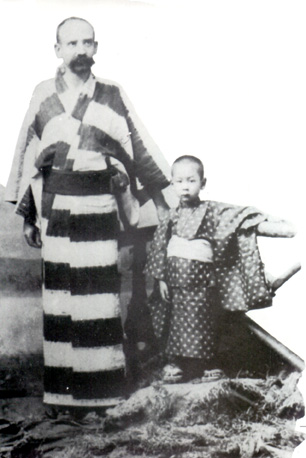
Venceslau de Morais had been living in Kobe from 1898. In 1899 he was appointed Consul of Kobe and Osaka. By the time when he was writing these postcards, he had already published some of his most important books. In 1895, Traços do Extremo Oriente (Sketches of the Far East) had come out followed by Dai-Nippon in 1897. He had already published some of the "Cartas do Japão" (Letters from Japan) which were sent to the Portuguese newspaper O Comércio do Porto from 1902 to 1913, O Culto do Chá (The Tea Cult) in 1905, and Paisagens da China e do Japão (Landscapes of China and Japan) in 1906, a book dedicated to "the memory of two great men", João Vasco and Camilo Pessanha, both of whom he had met in Macau.
During the period covered by this correspondence, Japan had emerged as the foremost power in Asia. From 1894 onwards, Japan had entered a new stage in its international relations, starting with the war against China and culminating in a full-blooded military victory against Tzarist Russia. A series of social and economic reforms had followed and 1886 to 1905 saw the beginning of modern Japan's development. Industry was modernized. Kobe, like Tokyo, Osaka and Yokohama, was to become one of the most important centres for heavy industry and flourishing business activity. Now that the war against Russia was over, the "Dai Nippon Teikoku" was established- a powerful empire which included Taiwan, the Liaotung Peninsula and later Korea.
Morais greatly admired Emperor Mitsuhito (Meiji), the head of this new empire, usually seen riding on horse-back magnificently attired in the uniform of a field-marshal. This was a time of strident, extreme nationalism. In 1905, Japan had won two battles against foreign enemies. The wars against China and Russia had been full-scale and had required the maximum efforts of the entire Japanese population. A new temple, the Yasukuni Jinja, became the focus of fervent nationalism calling for total sacrifice. In just a few decades, Japan had developed a formidable army and a united nation whose symbol was the Meiji Emperor. The Meiji Restoration had a unique character: a capitalist revolution organized by the samurai in the service of the nationalist cause. The Restoration prepared the way for Japan's present dynamism.
The Meiji Period saw extreme nationalist literature come to light (Niku Dan, 1906, Kono Issen, 1911) although the most important work of the period, Ippei Sotsu (1908) by Tayama Katai, concentrated on the futility of the bloody sacrifices in the war against Russia.
Mutsuhito's death in 1912 was the symbolic end of a period of great triumphs. An imperial state had been established and the population had been welded together into a united block.
The collection of postcards published here shows that Morais identified with the Japanese people and the official aims of the Meiji Period.
The postcards deal with much the same topics as were covered in the Cartas Íntimas (Private Letters) published in 1944. Most of them were sent to Joaquim de Morais Costa, Morais' nephew. Joaquim was the son of Emília Reginna Perpétua de Morais, the writer's eldest sister. Joaquim Costa spoke admiringly of his uncle in 1944 when discussing his correspondence:
"These writings were not intended for the printing press and they were written in a careless manner but for this very reason they allow us a genuine insight into his delicate, affectionate soul. At each step we find evidence of friendship, solicitous interest as to the health of his mother, sisters, and even his nieces and nephews with whom he had lived for only a few months when they were only knee-high. This collection of letters cannot be compared to his excellent literary output, the value of which has long been rightly recognized. It is for the heart to appreciate them and the reader will certainly encounter many moving passages. Even today, I still read these precious papers, now yellow with age, with delight and I have always found some worthwhile advice in them, a breath of fresh air in a moment of despondency. And now I am turning them over to the confident hands of the authors of "Amores", and I do this in the firm belief that this is a gesture of due respect and admiration for my uncle, whom I regard as having been a second father to me." (3)
This belief is corroborated by existing correspondence. In a letter of 1902, Morais had written: "The lad must be growing into a man now that he is seventeen years old, if I'm not mistaken. It seems that he is sensible and applies himself, which is the main thing. You can depend on him to bring you many more years of joy, earning his way in the world honestly. As I have already told you, when the time comes for him to look for a job, if you don't have enough contacts, perhaps I can do something for him. Get in touch with me then, if need be. I can still remember the boy's affection, it was really nice when he came to hug me in the street, and also the little girl, no bigger than a flea then. Good times! I'll still see them some day..." Morais was to keep his promise. He contacted friends of his at the time, Carlos Campos, Vicente Almeida d'Eça and João Moreira de Sá, and obtained employment for Joaquim in the Nyassa Company. In a letter of 1903, he turns down any attempt to thank him for his assistance and gives further advice: "My three friends can still be of great use to him, but he ought to make use of this because they are also his friends". In another letter in 1904, he returns to the same subject: "I am delighted with the good news about Joaquim, happy in his studies and valued by his superiors: just as well that it has turned out like this". According to a further note, Joaquim continued in the Niassa Company "where he eventually became General Secretary after his predecessor, Vicente de Almeida de Eça died". His death came in 1929.
The collection also includes two letters written to Joaquim's wife.
Most of the postcards were written either in 1907 or 1910, four of them being written in the former year and five in the latter. There is nothing sensational about the contents. In the first group, Morais refers to a Luís Guimarães, the Brasilian business attaché in Tokyo, an obscure budding journalist and the author of some "Cartas Japonesas" ("Japanese Letters") which were apparently published in Novidades. Morais admired neither the literary output nor the personality of this fellow Portuguese speaker. On other postcards there are references to family trips to Montachique and Belas, places which lent themselves to walks in the country air. There is a reference to his nephew's honeymoon in Sintra. Other postcards are more of a routine nature conveying thanks for birthday greetings and returning Christmas wishes. Some postcards mention close friends and family members such as Virgínia, the old servant, or his niece, Maria. Two of the postcards written in 1910 mention Vicente Almeida d'Eça and Sebastião Peres Rodrigues who were close friends at the time. Morais was to break from both of them years later.
The photographs on the postcards are of more interest as they reflect Morais' tastes and attitudes. Five of the seventeen postcards show graceful female figures dressed in kimonos, one shows the wildlife of Japan, eight portray landscapes and monuments (including Buddhist and Shinto temples), and two recall the war between Japan and Russia which Morais followed with a passionate interest. Thus, the majority of these postcards evoke a traditional world which was rapidly being overtaken by the speedy modernization of a country which only four decades before had been a feudal society. There are images of chrysanthemum displays, cherry blossom in the spring, young women beside rickshaws or practising traditional arts, ancient temples in places overflowing with historical references such as Sumadera. In civilian terms, the modernization of the country is shown only by the image of a railway. Modern Japan is best reflected by two symbols of formidable military might: the cruiser Akashi and General Nogi. This general was to be praised in the Cartas do Japão in pages brimming with enthusiasm, part of his fame arising from the fact that he finished his samurai days by committing seppukku (ritual suicide). It is a well known fact that Morais preferred feudal Japan, in particular the Tokugawa Period. What he admired most about modern Japan was the militarism which allowed the country to resist western imperialism successfully..
During the time that these letters were written, Venceslau de Morais became a well-known writer in Portugal. He was admired by men like Fialho de Almeida and Alberto Osório de Castro who were exponents of 19th century fin-de-siècle decadence. In 1912, Morais went to Suma with O-Yoné to visit the grave of Atsumori, a young warrior who was celebrated in Japan's plays and epic literature. But 1912 was a fated year: O-Yoné was to die months later.
This set of postcards finishes in this tragic year for the author of Dai-Nippon. Jaime do Inso, who saw Morais in Kobe in November of 1912, described him thus at this most bitter point in his life: "A certain air of sadness, unhappiness, perhaps even physical exhaustion, shows through in his appearance, his beard is getting white and, moreover, his words are sometimes filled with bitterness".(5)
From 1912 onwards, the shadows which hung over him were to make his last years much more gloomy. Increasingly, Morais was to escape into himself in search of peace and solitude. The final stage of his life began in 1913 with his mournful exile to Tokushima.
NOTES
(1)Armando Martins Janeira: "Cronologia", Wenceslau de Moraes, Antologias Universais, (Lisbon, Portugália Editora, 1971), LXXVII.
(2)E. H. Norman: Japan's Emergence as a Modern State: Political and Economic Problems of the Meiji Period, (New York, 1940); John Whitney Hall: Japan: From Prehistory to Modern Times, (New York, Delacorte, 1970), pp. 305-307;
Richard Storry: A History of Modern Japan, (New York, 1960); J. N. Westwood: Witnesses of Tsushima, (Tokyo, Sophia University Press and Talahassee, Florida, Diplomatic Press, 1970).
(3)Letter from Joaquim de Morais Costa dated Lisbon, 27th of February, 1904, addressed to Ângelo Pereira. Cartas Íntimas de Wenceslau de Moraes. Preface and notes by Ângelo Pereira and Oldemiro César (Lisbon, Empresa Nacional de Publicidade,1944), p.9.
(4)Letters addressed to Emília from Venceslau de Morais dated Kobe, 4th of March, 1902, 24th of March, 1903 and 24th of June, 1904. Ibid., pp. 59-60. In the Asian Library of Kyoto University of Foreign Studies there is correspondence from Morais to Carlos Campos. In a letter dated Kobe, 10th November, 1902, Morais names the friends whom he asked for help in finding work for Joaquim: Carlos Campos, Vicente Almeida d'Eça and João Moreira de Sá.
(5)Jaime do Inso, "O Exilado de Tokushima", Visões da China, (Lisbon, 1933), pp.307-314.
*Portuguese teacher in the University of Kyoto. Researcher, author and essayist having published several works dealing with the Portuguese in the East and particularly in Japan.
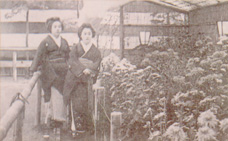
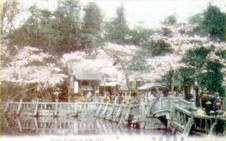
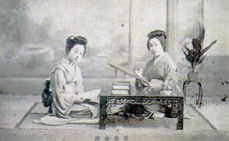
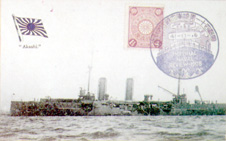
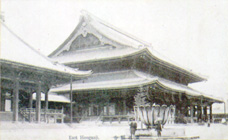
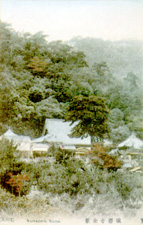
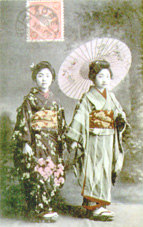
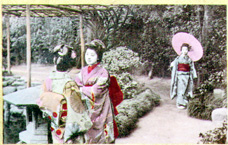
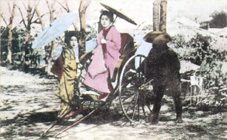


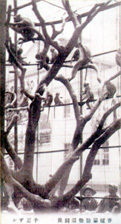
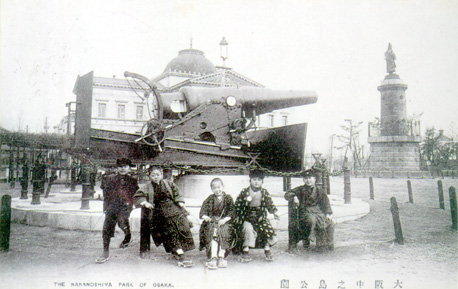
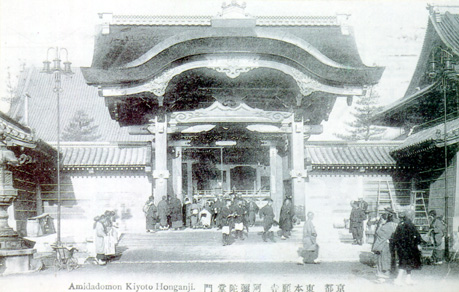
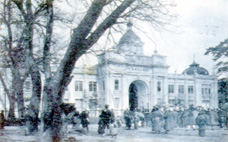
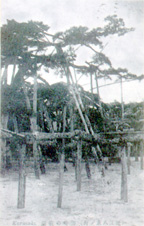
Sixteen picture postcards from Venceslau de Morais

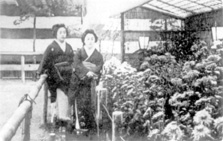
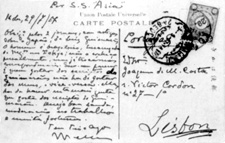
Via S. S. "Asia"- Portugal(1)
Exmo Snr.
Joaquim de M. Costa
r. Victor Cordon no27-1o
Lisbon
Kobe, 29/7/07
Thanks for the 2 papers with articles on Japan by Luiz Guimarães. He is Brasilian, the Business Attache in Tokyo; I don't know him personally but we have written to each other. It seems to me that anyone who likes his writing will not like mine and vice-versa. But there must be many more people who like his writing. Wishing you good health, moderation in your work and great fortune.
Your Friend and Uncle
W. M.
NOTE
(1)Illustration: two Japanese ladies dressed in kimonos, standing beside a bed of chrysanthemums.
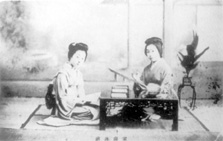
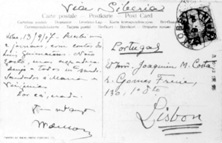
Via Siberia(1)
Portugal
Ex. Snr. Joaquim M. Costa
r. Gomes Freire, 130, 1o dto
Lisbon
Kobe,13/9/07
I received two more newspapers with stories by Luís Guimarães. I don't like them but thanks all the same. I wish you all good health. Remember me to Maria(2)and Virginia(3).
No news at this end.
Your great friend
W. de Morais
NOTES
(1)Illustration: Two Japanese girls seated at a low table. One is holding a book while the other is writing a poem.
(2)This must be Joaquim Costa's sister, Maria dos Prazeres to whom Morais had sent a letter on the 4th of June, 1901. Cartas Íntimas, p. 105.
(3)"This was a devoted servant of the family for many tens of years. Now her mortal remains lie next to those of the two "little ladies" as she always called the writer's sisters." Annotation by Angelo Pereira and Oldemiro Cesar. Cartas Intimas, p.78.
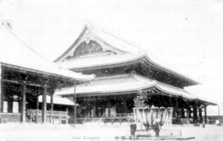
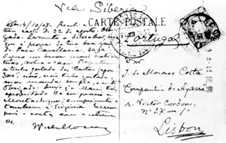
Via Siberia(1)
Portugal
Ex. Snr.
J. de Moraes Costa
"Companhia do Nyassa"
r. Victor Cordon, No27-1o
Lisbon
Kobe, 4/10/07.
I received your letter of the 22nd of August. Thank you. I'm sorry about the inconvenience, but it's proof of your good health. You should get away to Cavallaria...! I'll be waiting to hear from you about this shortly. You ask if I've been enjoying the "Cartas Japonezas"; no, I've not, but send them all the same, and thanks very much. I hope Maria has benefitted from her trip to Montachique(2); regards also to Virgínia. Write and know you can depend on the esteem of
W. de Moraes
NOTES
(1)Illustration: "East Honganji". Higashi Honganji, known formally as Shinshuhonbyo, was founded in 1600 by Ieyasu Tokugawa as a rival to Nishi Honganji. Within the grounds are some of the most beautiful example of Japanese Buddhist architecture. The Goei-Do (Founder's Pavilion), reconstructed in 1895, is the largest wooden building in Kyoto and perhaps in the world. The Shosei-en garden, also called Kikoku-tei, was designed in 1653 by Jozan Ishikawa (1583-1672) who was noted for his talent in matching colour and shape. (It was Ishikawa who also designed the marvellous Shisen-do garden). The garden contains several buildings around Lake Ingetsu, with the "Thirteen Beautiful Landscapes" mentioned in poems.
Higashi Honganji is located between Karasuma and Shichijo in Shimogyo-ku. It is one of the centres of the Jodo Shinshu (Pure Earth) sect.
(2)Montachique: a town near Lourdes.
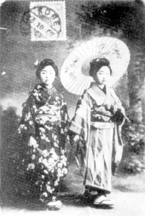
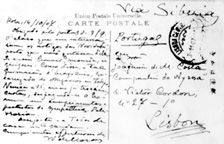
Via Siberia(1)
Portugal
Exmo. Snr.
Joaquim de M. Costa
"Companhia do Nyassa"(2)
r. Victor Cordon, no27-1o
Lisbon
Kobe, 14/10/07
Thank you for the postcard of 3/9. Of course I was interested in the articles from "Novidades", even though I did not like them. If there are any more, send them if you want. As I said, that Guimaraes is Brasilian, the Business Attache in Tokyo. I have never seen him but we have already written to each other, the man falling over himself to be polite. All a load of nonsense.
I wish you and everyone else at home good health.
With great affection from
W. de Moraes
NOTES
(1)Illustration: Two Japanese girls in kimono.
(2)"The territories of Niassa were administered by a royal company, the Niassa Company, established in 1893 and which took over the territories in 1897. This company was responsible for the founding of port Amelia in Pemba Bay and for occupying several important points on the western border. In 1930, the administration was handed over to the State. The Company issued its own stamps, the first of which came out in 1908." "Niassa", entry in the Grande Enciclopedia Portuguesa e Brasileira, XVIII, pp. 706-707.
Port Amelia is now called Pemba. It was founded in 1897.
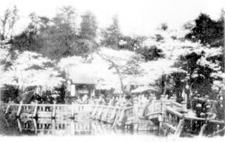
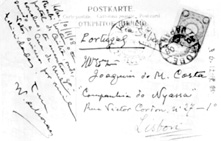
Portugal(1)
Illmo Exmo Snr
Joaquim de M. Costa
"Companhia do Nyassa"
Rua Victor Cordon, no27-1o
Lisbon
Kobe, 10/11/08
Yesterday I received your postcard from Sintra where, I imagine, you are spending your honeymoon.
I wish you every happiness that life can bring.
Your
W. de Moraes
NOTES
(1)Illustration: "Cherry blossom at Shiba Park". "Tokyo Shibayama Uchigawa".
(2)Sintra, a town to the north of Lisbon. "In all of Portugal, in all of Europe, Sintra is one of the most exquisite places that the prodigious capacities of nature has conjured up." Afonso Lopes Vieira, Guia de Portugal, I (Gulbenkian Foundation, 1983), p.493. Included in the famous monuments found there are the Royal Palace, the Palace of Sadness and the Moorish Castle.
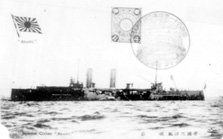
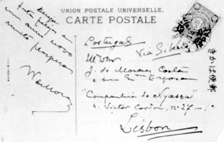
Portugal
Via Siberia(1)
Illmo Exmo Snr
J. De Moraes Costa
e a sua Exma Esposa
"Companhia do Nyassa"
r. Victor Cordon, n o27-1o
Lisbon
Wishing you a happy holiday and a prosperous new year.
W. De Moraes
NOTES
(1)Illustration: "Japanese Cruiser Akashi".
A stamp over the postage stamp shows the prow of a ship: "Kobe-41-11-16. Imperial Navy Review - 1908". The postmark on the other stamp is "Kobe-5.12.08-Japan". Moraís mentioned the battleship Akashi in his account of the battle of Tsushima, dated 8th of June, 1905. A Vida Japonesa (Oporto, Lello & Irmao, 1905), p. 68.
The Akashi was built in Yokosuka in 1894 and was launched in 1897, the sister ship of the Suma. At the beginning of the war against Russia, the Akashi went into action in Chelumpo. It participated in the Yellow Sea War with the Suma. On the 10th of December, 1904, the Akashi was damaged by a mine and after being given temporary repairs in Dal'niy, went on to Sasebo. In Tsushima the Suma served with the Chiyoda in the Sixth Battleship Squadron while the Akashi served in the Fourth Battleship Squadron.
The Akashi carried weapons made by Elswick, Hotchkiss, Nordenfield and Maxim. The Akashi and the Suma were disarmed in 1922 and taken out of service on 1927. Anthony J. Watts and Brian G. Gordon, The Imperial Japanese Navy, (London, MacDonald, 1971), P. 100; Hans Georg Jentshura, Dieter Jung and Peter Mickel, Die Japanischen Kriegschife 1869-1945(Munich, J. F. Lehmanns Verlag, 1970), p.172.
The Akashi took part in the defeat of Tsingtau in 1914: "All the choice assignments went to the Second Squadron, which would blockade the German protectorate, clear any mines obstructing a landing, and support the land assault on Tsingtau. Under Vice-Admiral Sadakichi Kato, this Squadron would carry the basic naval responsibility". A note adds: "The Second Squadron consisted of several old battleships captured in the Russo-Japanese War and some native-built cruisers: the battleships Suwo (ex Pobjeda), 12,900 tons with four 30.5cm guns; Iwami (ex Drel), 13,700 tons with four 30.5cm guns; Tango (ex Poltawa)with four 30.5cm guns; the old coastal armored ships Okinoschima (ex Apraxin), 4,200 tons with three 25cm guns; Mishima (ex Senyawin), 4,200 tons with four 25cm guns. With these units were three armored red cruisers (Iwate, Tokiwa; Yakumo) all close to 10,000 with four 20cm guns, and eight light cruisers (Chitose, Tone, Mogami, Yodo, Akashi, Akitsushima, Chiyoda, Takachiho) of widely ranging size and power. In addition there were two destroyers and twenty-seven boats, as well as several repair and supply vessels". Charles B. Burdick, The Japanese Siege of Tsingtau (Handem, Conneticut, the Shoe String Press, 1976), pp. 80,222.
The victory in Tsingtau had major repercussions: "As the Japanese army marched through Tsingtau, they heralded the power relations for a new era. The old European centered world with its imperialistic pretensions, historical pride, and traditional structure was leaving history's stage". Ibid., p. 197. Competition between the two strongest forces in the Pacific region, Japan and the United States, was to become more intense. This competition was foreseen by Venceslau de Morais although he makes no mention of the siege of Tsingtau in his work.
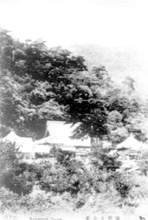
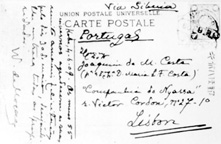
Via Siberia(1)
Portugal
Illmo Exmo Snr.
Joaquim de M. Costa
(for Exma Sra D. Maria L. F. Costa)
"Companhia do Nyassa"
r. Victor Cordon, no27-1o
Lisbon
Kobe, 4-6-09
With 55 winters behind me, I thank you for your kind wishes for the 30th of May, and send you every hope for success.
W. de Moraes
NOTE
(1)Illustration: "Sumadera, Suma", "Sumadera zenkei".
Suma is located near Kobe in Hyogo Prefecture on the West of Honshu. Suma has long been famous for its pine forests and beaches of white sand. It was mentioned in the Ⅷth century poetry anthology Man Yoshu and was the setting for many of the scenes in Genji Monogatari. In addition to this, it was a battlefield during the war between the Taira and Minamoto clans (1180-1185). After the Taira were defeated in Ichi-no-Tani, Atsumori was beheaded. His grave stands in Suma. The young warrior's fate is also the subject of a Noh play, Atsumori, written by Seami Motokiyo during the Muromachi Period (1333-1600), a work filled with tragic lyricism. The statue of Atsumori is located in a corner of Suma-no-Ura Park. Morais visited Atsumori's grave in 1912 accompanied by O -Yoné. The description of the grave was one of his most memorable pieces of writing and is given the title of "Atsumori's Grave" in the book O -Yoné Ko-Haru. The Portuguese film-maker described the place: "This is Suma beach, an area laid out with the geometrical skill of Japanese tradition. There must be few places in Japan where so many memorable events have taken place. The Japanese novel originated in the 10th century describing scenes which took place here: the tales of Ise and Genji. Suma was also the setting for famous scenes in Kabuki and Noh drama. The poet Banho wrote some well-known haiku there and a countless number of artists, musicians and singers make reference to the spot in their work. It was written in the pages of fortune that one of the greatest passages of writing produced by Morais should have been about a visit to the grave of Atsumori, a warrior who died at the peak of his years on Suma Beach. Atsumori is one of the major figures in an epic cycle, the saga of the Heike, and he is one of the best remembered historical figures in modern Japan. Ezra Pound spoke of him and of Genji in the preface to his translation of a Noh play Suma Genji! Morais penned a sublime page which even now I cannot reread (or hear) without experiencing an inexplicable surge of emotion" "O bloconotas do realizador - "A Ilha dos Amores" de Paulo Rocha vai transformar-se em Album" ("The director's note-book" - Paulo Rocha's film "A Ilha dos Amores"* is going to be edited) - Mais Semanario, the supplement to Semanario, n227 of the 31st of March, 1988, p.20. There is a version of a Noh play by Pound, Suma Genji, based on Fenellosa's notes. Pound made an allusion to "Genji at Suma" in Canto LXXIV of the Cantos, Earl Miner, The Japanese Tradition in British and American Literature (Princeton University Press, 1958), pp. 137 and 141. On the subject of Ezra Pound and Ernest Fenollosa, "Noh" or Accomplishment (London, Macmillan, 1916) and Hugh Kenner, The Translations of Ezra Pound, (Norfolk, Conn., New Directions, 1950)
Suma-no-Ura Park occupies a narrow strip of land between Suma Beach and Mount Hachibuse. In Spring, the cherry trees cover the park with a white blanket of blossoms. There are two monuments in the park: one built in 1286 by Sadatoki Hojo of the powerful Hojo clan to show his admiration for Atsumori Taira, and the other (Midori-noto) to commemorate a visit by the Emperor and Empress in 1954.
Sumadera is a temple dedicated to the doctrines of Singon Buddhism. It is famous for having been dedicated by Naozane Kumagai to the memory of Atsumori who died in combat at the age of sixteen. Atsumori's flute ("Aoba-no-fue") is kept in the Treasure House of the temple. In the area of music, Sumadera is famous because of Yukihara Ariwara, a courtier of the Ⅸth century who is supposed to have been the model for the Genji in Genji Monogatari. Banished to Suma, he invented a one-string harp ("ichigenkin"), the Suma harp.
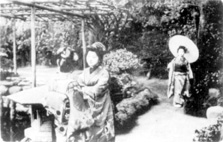
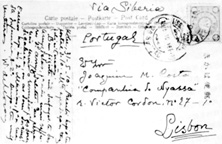
Via Siberia(1)
Portugal
Exmo Snr.
Joaquim M. Costa
"Companhia do Nyassa"
r. Victor Cordon, no27-1o
Lisbon
Kobe,31-5-10
I received your postcard of the 10th today. Many thanks for your greetings.
Your were quite right to have your tonsils taken out to avoid any further tonsilitis. What a pity the same treatment cannot be used for headaches or kidney pains! I am writing to the 2 Marias today at Rua da Infancia, 8-2o. With every best wish.
W. de Moraes
NOTE
(1)Illustration: three Japanese girls in a garden dressed in kimonos, one of them carrying a parasol.
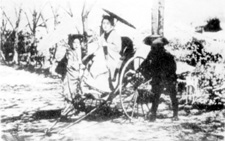
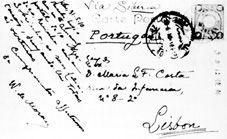
Via Siberia(1)
Portugal
Ex. Snr.
D. Maria L. F. Costa
rua da Infancia, (2) no8-2o
Lisbon
Kobe, 31-5-10
I received your kind postcard of the 10th today. Many thanks my dear niece, for your birthday greetings and I wish you every happiness.
With great affection from
W. de Moraes
NOTES
(1)Illustration: Two Japanese girls in kimonos both carrying parasols, one sitting in a rickshaw while the other stands beside it. The driver is also next to the rickshaw. The girls have a severe expression on their faces.
(2)The Rua da Infancia, situated near Largo de S. Vicente with a sixteenth century palace which was the home of the Secretary of State Pedro Vieira da Silva, is now called Rua da Voz do Operario opening out onto the Larga da Graca. Guia de Portual, I (Lisbon, Gulbenkian Foundation), 2nd Edition, 1983), p.294.
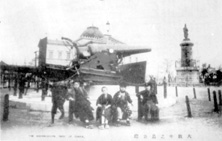
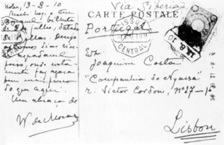
Via Siberia(1)
Portugal
Ex. Snr.
Joaquim Costa
"Companhia do Nyassa"
r. Victor Cordon, no27-1o
Lisbon
Kobe, 13-8-10
I received your kind postcard of the 3rd of July from Bellas. I hope you have a lovely time in this spot which I am sure is cooler than here.
An embrace from
W. de Moraes
NOTE
(1)Illustration: "The Nakanoshima Park of Osaka". Five little boys in front of a cannon. In the background there is a statue and a classical building with a pediment. This is Osaka's Town Library. (Nakanoshima-shi - Rinkaishoten, 1974). The statue is of Toyotomi Hideyoshi. The cannon was a monument commemorating the Russo-Japanese War but both the cannon and the statue were melted down during the Second World War. (Kitaku-shi, 1955). To learn more of the painful victory of the first Russo-Japanese War, read Alvin D. Cox, Nomonhan: Japan against Russia (Stanford, Stanford University Press, 1985) which discusses the excessive confidence, the lack of knowledge about the enemy and the faulty strategies which led to the defeat in Nomonhan in 1939.
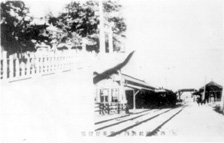
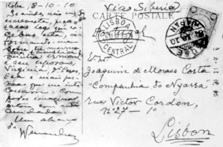
Via Siberia(1)
Portugal
Exmo Snr.
Joaquim M. Costa
"Companhia do Nyassa"
r. Victor Cordon, no27-1o
Lisbon
Kobe, 8/10/10
If you haven't already written to me, I beg you to do so as soon as you receive this letter telling me how you, your family, my sister and her husband, Virginia, Dr. Peres(2), Eca and everyone else I know are. As you can imagine, I am in high spirits.
An embrace from
Wenceslau
NOTES
(1)Illustration: Two photographs. On the top left hand corner there is a picture of a Shinto temple. On the bottom right hand corner there is a railway. "Nishinomiya Jinja Omotemon shita Densha Teiriujo".
(2)Dr. Sebastiao Peres Rodrigues, a doctor in the Navy. "He served some time with W. de Moraes to whom he was also doctor and even confidant. After Moraes' elder sister died, he asked Dr. Peres to be guardian for his niece and nephew." Angelo Pereira and Oldemiro Cesar, Cartas Intimas, p. 50.
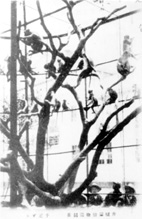
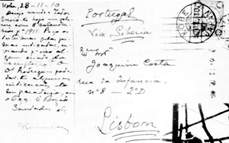
Portugal(1)
Via Siberia
Exmo Snr.
Joaquim Costa
Rua da Infancia, no8-2oD
Lisbon
Kobe, 28/11/10
I wish you all health. I'm sending off a parcel today with 8 calendars for 1911. Please distribute them to the people indicated. Send a servant from the office to do this. Dr. Rodrigues Peres can give you an idea of his whereabouts or Eca's. And thanks.
All the best from
Wenceslau
NOTE
(1)Illustration: "Koroen Dobutsen Shiyou Senbikizaru". The photograph shows monkeys in a zoo.
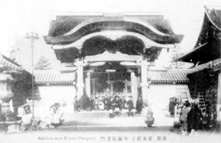
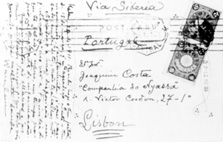
Via Siberia(1)
Portugal
Exmo Snr.
Joaquim Costa
"Companhia do Nyassa"
r. Victor Cordon, 27-1o
Lisbon
Kobe, 24/4/1911 I received your postcard of the 15th of March today, for which many thanks. I know what you must be going through; take care of yourself and don't work too hard.
Many thanks for your readiness to go and see the Family which I mentioned; and I'll be waiting for a letter from you with all the news.
Regards to the Marias and my best wishes for your good health.
Wenceslau
NOTE
(1)Illustration:"Amidadomon Kiyoto Hongaji" Hongaji (Temple of the Original Promise) was founded in 1321. In the temple there is a statue of Shinran (1173-1263), the patriarch of the Pure Earth Buddhist sect. After a turbulent history, both Nishinhonganji and Higashi Honganji became pillars of respectability during the Edo Period (1600-1863) by preaching submission to the authorities. Jodo Shinshu (the Pure Land Sect) is one of the thirteen traditional schools of Buddhism. The sect was founded in 1224 by Shinran who then compiled his fundamental work Kyogyo Shinsho. Shin Buddhism came at the same time as Mahayana Buddhism. During the Sengoku Period (1467-1568) the Honganji outstripped its rivals and became an ecclesiastic organization in its own right. It established both religious and secular links, made alliances with armed forces and took over whole provinces. The sect was almost completely wiped out by Oda Nobunaga. At the beginning of the XⅦth century, there was a split in the sect with two rival branches adhering either to Nishi or Higashi Honganji in Kyoto which remain to this day with millions of worshippers. The present Nishi Honganji Temple dates from 1591. It was built on land ceded by Hideyoshi Toyotomi. As well as having Buddhist works of art, there are five buildings, representing architecture from the Momoyama Period, designated as National Treasures. Kokeino-niwa is the original garden.
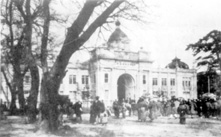
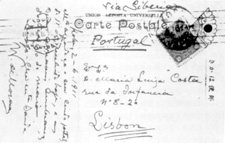
Via Siberia(1)
Portugal
Ex. Sa
D. Maria Luiza Costa
Rua da Infancia no8-2o
Lisbon
Kobe, 2/6/1911
Thank you very much for the lovely postcard of 11/5 which I received today, and for your fond wishes for the 30th of May.
Wishing you good health
W. de Moraes
NOTE
(1)Illustration: "Kiyoshinkai Seimon, Kobe" (Kobe Shussai Kyohoinkai Kaijo Seimon no Kobe".)
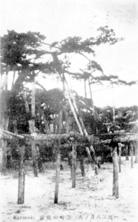
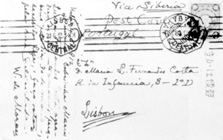
Via Siberia(1)
Post Card
Portugal
Exma Sra
D. Maria L. Fernandes Costa
R. da Infancia, 8 2oD
Lisbon
Kobe, 4-6-1912
My Dear Niece Maria Luisa Fernandes Costa, thank you very much for your kind congratulations for the 30th of May which I received today. I wish you every happiness.
W. de Moraes
NOTE
(1)Illustration: Karasaki. "Omihakei Karasaki no Iau".
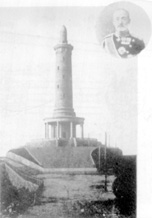
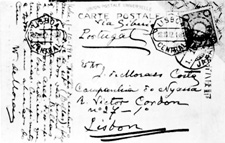
Via Siberia(1)
Portugal
Exmo Snr
J. de Moraes Costa
Companhia do Nyassa
R. Victor Cordon no27-1o
Lisbon
Kobe, 1-10-1912. I have just received your p. c. of the 12th of Sept. (Bellas) and am delighted to know that you are all well and that you are in Bellas enjoying the fresh air. I'm waiting for the good news of which you told me. Best wishes to everyone and an embrace from your
W. de Moraes
NOTE
(1)Illustration: "General Nogi" "Riojin Hakugyoku San Hiochu Kinen to Gunshin Nogi Shogun".
In one corner there is a photograph of the general, on the left there is a tower crowned with a grenade-shaped cupula commemorating the general's military glory.
Maresuke Nogi (1849-1912), General in the Army, was born in Edo (Tokyo) to a family from Choshu (now Yamaguchi Prefecture). During the Satsuma Uprising in 1877, his regiment was defeated. This event was to obsess Nogi for the remainder of his life. He studied in Germany during 1887-1888. He lived by military ideals, and the traditional samurai values of discipline and sacrifice. During the Sino-Japanese War of 1884-1885, Nogi commanded the First Infantry Brigade, gaining fame in the conquest of the Liaotung Peninsula and its main military base Lushun (Port Arthur). This successful campaign led to him gaining command of a division, promotion to the rank of lieutenant-general and the title of Baron. Later, Nogi took part in the final defeat of Taiwan which was acquired by Japan after the war and, from 1896-1898, he lent his services as Governor of this colony. This was a frustrating time for Nogi given his inaptitude for colonial administration and due to the corruption and incompetence of his subordinates. At the outbreak of the Russo-Japanese War in 1904, Nogi was promoted to general and took command of the Third Army for the attack on the formidable Russian military positions in Port Arthur. Japan had been forced to surrender Liaotung Peninsula to China in 1895 and China had later leased the territory to Russia. In the autumn of 1904, Nogi organized a series of bloody attacks which were at once daring and futile costing fifty six thousand Japanese lives. He considered himself personally responsible for these sacrifices. Only after intervention on the part of General Kodama Gentaro, sent by the High Command to advise Nogi, did he follow a more appropriate course of action which included the use of heavy cannons at short-range. Port Arthur ended up in the hands of the Japanese Army. In spite of his ineffective leadership of the Third Army in the final campaign of the war in Mukden (now Shenyang), the stoic acceptance of the death of his two sons in combat - both of them infantry officers - earned Nogi the admiration of the Japanese public and he was treated as a war hero when he returned from the war. He was made a count in 1907, and in the same year he was nominated rector of the aristocratic and prestigious College which is now Gakushuin University where he enforced a severe regime of patriotism, austerity and masculine virtue. The fact that he and his wife committed ritual suicide on the evening of Emperor Mutsuhito's funeral (13th September, 1912) caused a tremendous sensation because on the surface it seemed to reflect Nogi's protest against the luxuries and corruption of modern Japan although it could have been an act of atonement for mistakes made during his military career. Nogi's self-destruction had a particularly profound effect amongst the Japanese intelligentsia. Natsume Soseki included the event in his novel Kokoro (1914) in an attempt to emphasise the problem of his own identity, lost in the changing values of modern Japan. For Mori Ogai, Nogi's suicide had the effect of rekindling an interest in Japanese tradition, shown in his subsequent devotion towards his country's history, the most important part of his creative output. "Junshi" became the subject of Abe Ichizoku, a novel written in 1913. For the public at large, Nogi became an idol and a symbol of loyalty and sacrifice but in the Japanese army, his professional reputation had always been open to question.
Bibliography on Nogi:
Matsyhita Yoshio: Nogi Maresuke (1960)
Meiji no Guntai (1963)
Mark Peattie: "The Last Samurai: the military career of Nogi Maresuke", Princeton Papers on East Asian Studies, I, Japan.
A critique written during the Taisho Period can be found in Akutagawa's book Shogun (1922) and in Kuroshima Denji's book Sori (1922).
Venceslau de Moraís showed an enormous amount of admiration for Nogi whom he regarded as "the first identifiable figure, with no doubt at all, of Japan's modern army". He noted that Nogi's suicide had been described by the press and the public as an act of great loyalty and patriotic love towards the deceased emperor. He approved of the suicide: "Nogi, because of all that he saw, all that he felt, because of the loss of his two sons, distanced himself from the rest of humanity and became an isolated entity, living no doubt, under the weight of his memories of the battles. Under these circumstances, what good was life to him? None at all". He concluded: "Anyway, from whichever angle one views it, Nogi's suicide is certainly a powerful example of public duty done Japanese style which will serve to keep what we could call the patriotic fanaticism to which Japan owes all its progress and glory, unique in this world, alive in future generations". Cartas, VI, pp. 115-118. Armando Martins Janeira, Wenceslau de Moraes, Antologias Universais (Lisbon, Portugalia Editora,1971), pp. 184-187.
(2)Belas - a town on the outskirts of Lisbon. In 1924 it was a "delightful little town with streams running at the foot of the Carregueira Hills, a summer resort where historic farms, carpeted with pine forests, give off an aroma and provide dense shade. Everywhere, there is the surprise of trickling springs in the silent meadows which lead up to commanding heights with sober, placidly grandiose views". Raul Proenca, Guia de Portugal, I (Lisbon, Gulbenkian Foundation, 1983), p. 487.
(*)T. N.:"A Ilha dos Amores": the title of this film is taken from the mythical island encountered by the sailors in Canto IX of the Portuguese epic poem Os Lusiadas by Camoes.
start p. 42
end p.